January 26, 2020 | By Soledad Sanchez Valdez
Through May 10
Museum of Fine Arts
Details here
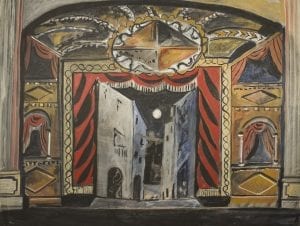
Imagine yourself contemplating your favorite painting. A two-dimensional world portrayed in a picture that is no more than a painted piece of canvas, but has the quality of taking you to a different dimension. Even if only for a few seconds.
Imagine you are suddenly transported inside the imaginary world of the picture. Finding yourself surrounded by the elements in the scene. Color, shape and texture are no longer contained by the frame. You can touch them, feel their proximity. You can smell them.
This is the most interesting experience I’ve had as scenic designer. The first time one of my designs was built for the set of Shakespeare’s Twelfth Night, l was magically transported. Symbolically reduced to the quarter-inch scale “little people” that I use as reference for my models.
In designing for the stage, the act of recreating the world for telling our own stories becomes an interpretation of the worlds where the stories of others take place. The principle of collaboration inherent in performing arts, expands the creative process to a different dimension with the voice of a universal language. In the urge for communicating those universal stories, different perspectives merge to allow the growing of a common project.
Seen through the eyes of extraordinary visual artists from the last two centuries, the magic of art for the stage is brought to us by a fascinating exhibition at the Museum of Fine Arts Saint Petersburg.
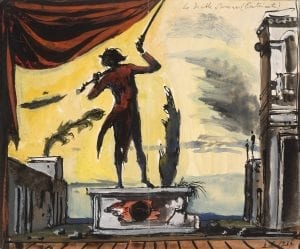
Art of the Stage, Picasso to Hockney brings original design studies and actual-size pieces for scenery, costumes, curtains and other works by artists including Henri Matisse, Joan Miró, Fernand Léger, Robert Indiana, Eugene Berman and Alexandra Exter, among others. All works are part of the extraordinary Tobin Collection of Theatre Arts in San Antonio, Texas.
A dynamic calendar of activities including dance, music, performance, lectures and film will run parallel to the exhibition that closes on May 10.
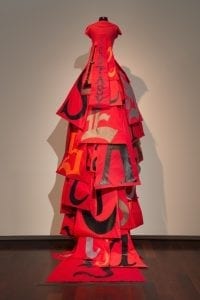
Before the exhibit opened, The Florida Orchestra performed at Tampa’s Straz Center for the Performing Arts and St. Petersburg’s Mahaffey Theatre. Combining projections, stage design, dance and music, the program included Rimsky-Korsakov, Beethoven, and Stravinsky, with original designs for set and costumes by Natalia Goncharova and Pablo Picasso as backdrops.
Introducing a series of collaboration projects between the arts, in the second act Tampa City Ballet, The Florida Orchestra and its resident artist Geff Strik presented a colorful new interpretation of the ballet Pulcinella.
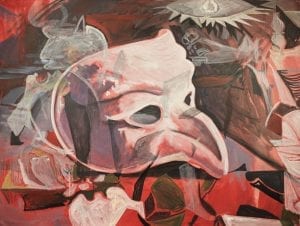
Considering there are an important amount of professional and community theatre companies in the Tampa Bay area, as well as a significant number of schools and performance arts training programs, this represents an exciting opportunity to see part of an extraordinary collection and honor the arts of the stage.
A delicious menu for a community eager for art, magic and history.
Find the complete schedule of events here
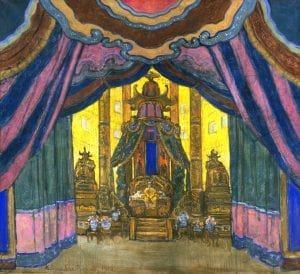
Designing the Stage
February 11, 2-3 pm
How do artists working in two dimensions translate their practice to the stage?
This talk will explore why the artists featured in Art of the Stage were drawn to theater, ballet and opera productions, where they could literally see their artworks in motion.
Many of the artists share an interest in portraying energy and movement in their work, from Natalia Goncharova (for whom rhythm was particularly important) to Pavel Tchelitchev (whose metamorphosis theory embodied multiple perspectives) and of course David Hockney (who is deeply influenced by the Cubist fracturing of the picture plane).
There will also be a discussion of the major art movements and theories that these artists represent, including Rayonism, Orphism, Constructivism and Cubism.
– Katherine Pill
More about this event here
More about Katherine Pill here
Dora Maar – Picasso,
the Drama and the Tears
February 12, 10-11 am

At the end of 1935, Dora Maar (1907-1997) was hired as a set photographer on the Jean Renoir film The Crime of Monsieur Lange. On this occasion Paul Éluard introduced her to Pablo Picasso. Their liaison would last nearly nine years.
Painter, photographer and Picasso’s ‘muse,’ Dora Maar photographed Picasso creating the famous black and white anti-war mural, Guernica. Picasso used these photographs in his creative process.
Dora captured with her camera each modification of the creation of a modern masterpiece. Her goal was ‘to preserve photographically not the stages but the metamorphoses of a picture.’ She is Picasso’s principal model, whom he often represented in tears – as The Weeping Woman.
Her passionate and disastrous liaison with Picasso ended in 1943. In this performance, Dora Maar shares her point of view of the role she played as she stood literally center stage of the Surrealist movement as it was sweeping the art world.
– Nan Colton
More about this event here
More about Dora Maar here
More about Nan Colton here
On March 11 from 10-11 am Nan Colton brings Catherine the Great and her artistic legacy to life. More here.
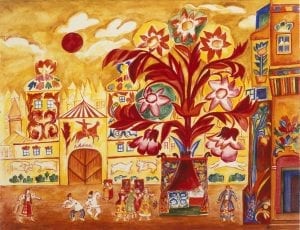
Opera and Dance
March 19, 7-7:30 pm
March 21, 3-3:30 pm
Dancer Charlotte Johnson and I are highlighting the fierce females featured in the exhibition.
Pulling from the works of two trailblazing women artists — Natalia Goncharova and Gertrude Stein — this multi-disciplinary program of opera and dance celebrates the artistic and political strides each made during the late 1800s and early 1900s.
Both women challenged gender and societal norms, questioning conventions of the day and seemingly serving as the ultimate rebels.
But a close examination of their work sees the inspiration each found in the higher ideals of the early 20th century.
– Susan Hellman Spatafora
More about these events here
More about Natalia Goncharova here
Bold quotes from Gertrude Stein here
More about Susan Hellman Spatafora here
More about Charlotte Johnson here
A Selection of Events
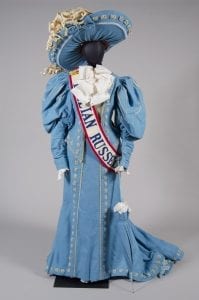
Cutting Edge
Feb 1, March 7, April 11 and May 9
11 am-12:30 pm
I was Robert Indiana’s assistant during the time he was commissioned by the Santa Fe Opera to design sets and costumes for Gertrude Stein and Virgil Thomson’s The Mother of Us All in 1976.
We rendered the maquettes [a model or study in three dimensions] in cut paper. The costumes were translated into cut-out felt and the floats were painted in flat bright colors, characteristic of Indiana’s painting style.
The MFA invited me to discuss how we created the designs in the unique medium of cut paper. I say, ‘It was like drawing with an x-acto knife.’
I am still ‘drawing with an x-acto knife’ and I have an upcoming exhibit at the Art Center Sarasota, titled The Razor’s Edge March 19- April 17. it will include subjects ranging from urban street corners to Coney island and Sarasota Circus Thrill Shows.
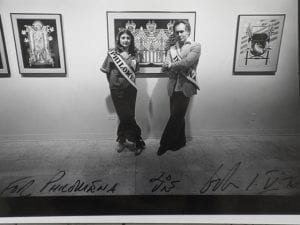
Here’s a photo of myself and Robert Indiana in front of the cut paper maquettes.
We are wearing felt sashes just as every performer in the production of The Mother of Us All wore – reminiscent of political rallies and town gatherings.
– Philomena Marano
More about these events here
More about Philomena Marano here
More about Robert Indiana here
TFO Concert at MFA
February 5, 2-4 pm
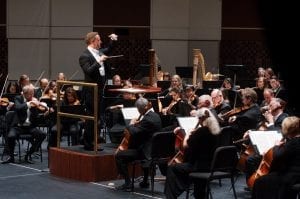
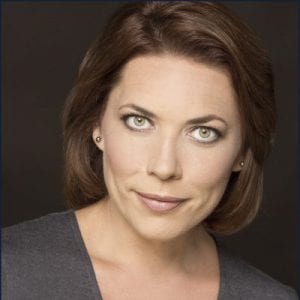 The Florida Orchestra does an intimate performance of Darius Milhaud’s La Creation du Monde and Stravinsky’s The Soldier’s Tale, narrated by local actor Becca McCoy.
The Florida Orchestra does an intimate performance of Darius Milhaud’s La Creation du Monde and Stravinsky’s The Soldier’s Tale, narrated by local actor Becca McCoy.
Both works celebrate the artworks featured in the MFA’s Art of the Stage exhibit. Daniel Black conducts.
More on this event here
More on The Florida Orchestra here
More on Becca McCoy here
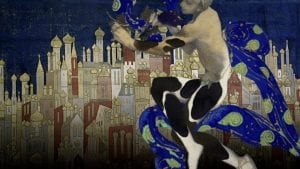 Diaghilev
Diaghilev
and the Ballets Russes
January 31, 11 am-12:30 pm
February 27, 6-7:30 pm
April 23, 6-7:30 pm
Narrated by Tilda Swinton, this film was made in conjunction with the exhibition Diaghilev and the Ballets Russes, 1909–1929: When Art Danced with Music.
The impresario Serge Diaghilev was the creator and driving force of the Ballets Russes. He persuaded, cajoled, and charmed the greatest talents of the early 20th century to join his company. Artists Pablo Picasso and Henri Matisse, composers Igor Stravinsky and Erik Satie, choreographers Michel Fokine and George Balanchine, and dancers Vaslav Nijinsky and Anna Pavlova all collaborated to realize Diaghilev’s dream of a seamless fusion of the arts.
The spectacular productions of the Ballets Russes dazzled audiences and revolutionized modern dance. This documentary includes footage of revivals of Ballets Russes performances by the Ballet Russe de Monte Carlo, the Paris Opera Ballet, the Joffrey Ballet and the New York City Ballet. Also featured are sets and costumes from Diaghilev’s innovative productions, as well as interviews with dancers, musicians, and scholars.
(2013, 60 mins) Produced by the National Gallery of Art, Washington.
More on this event here
More on the Ballet Russes here
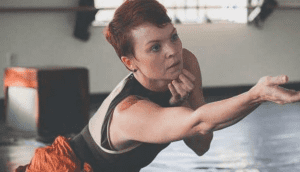 Process is Product
Process is Product
with Open/Space Collective
February 6, 6-8 pm
February 20, 5-7 pm
April 16, 5-7 pm
April 30, 6-8 pm
May 2, 2 pm performance with Q&A
Process is Product is a multi-tiered creative project involving four dancers/performance artists from across a diverse spectrum of age, race, gender and (dis) abilities, who will work together, improvising and thinking about improvisation in relation to performance in a museum setting.
This project takes its inspiration from the ballet Jeux d’Enfants (Children’s games), with Joan Miró’s contributing design work.
The dancers will re-imagine children’s games by taking up residency in the MFA on four “open process” workshop days to execute predetermined improvisational practices, utilizing public spaces.
These practices will sometimes look like play, and other times resemble problem solving.
Creative Makers: Helen French, Erik Wagner, Fernando Chonqui, Amber DiPietra, Noa Spector-Flock.
By observing how these improvisational practices gently engage with museum visitors and noting any persuasive, ‘game–like’ responses, this creative team will develop movement material to be incorporated into our May performance.
– Helen French
More on these events here
More on Fernand Legér here
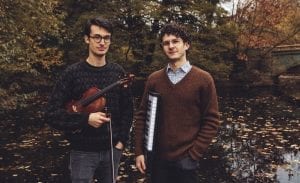
Re-Creation of the World
March 20, 7-9:30 pm
Centered around Darius Milhaud’s groundbreaking 1923 ballet La Création du Monde and inspired by costume and set designs by Fernand Léger, Re-Creation of the World explores the interconnected musical landscapes of 1920s France and America through works by Milhaud, Lili Boulanger, Germaine Tailleferre and Duke Ellington.
Presented in a new arrangement for piano and violin by escapeVelocity —composer-performers Robert Fleitz and Giancarlo Latta — Milhaud’s piece is in turn seen through the eyes of six composers whose work represents today’s diverse and far-reaching landscape of contemporary classical music.
These six composers — inti figgis-vizueta, Linda Leimane, Jessica Mays, Darian Thomas, Zeynep Toraman and Julie Zhu — offer six responses to Milhaud’s La Création, crafting a new narrative about the ‘creation of the world’ that reflects an updated, contemporary worldview.
– Giancarlo Latta
More about this event here
More about Robert Fleitz here
More about Giancarlo Latta here

Scheherazade to Salome
Live Writing Installation
& Performance
April 1-8, various times, Live Writing
April 9, 7 pm performance
How does a contemporary Arab American woman artist encounter Leon Bakst’s 1911 designs for the Ballets Russes’ Scheherazade? What happens when a queer, feminist, 21st century perspective is brought to Salome, in dialogue with Alexandra Exter’s 1917 costume design, or Jim Dine’s 1986 projection designs?

Poet and theatre-maker Andrea Assaf will be in residence, creating new work that responds to pieces in the exhibit.
At varied times during Museum hours from April 1-8, Andrea Assaf will be Live Writing on the Picasso stage, and throughout the exhibit.
Inspired by Suzan-Lori Parks’ Watch Me Work series at The Public Theatre, Live Writing is an experimental space where the writing process meets durational performance. Visitors to the Museum can watch Andrea explore research, creative movement, poetic forms or character development — and conversations (at limited times) about the work-in-progress or her creative process. You can also just bring a journal, and write yourself.
Join her for a tour through time and space, as she revisits, re-imagines, embodies and responds to the spectres of Salome and Scheherazade.
On April 9 at 7 pm, Andrea will offer a site-specific performance of the culminating new work, generated while in residence at the Museum.
More on this event here
View a re-creation of the Ballet Russes’ 1910 ballet here
More on Andrea Assaf here
RECOMMENDED READING
Explore the creative 19-teens and ‘20s and many of the artists who are part of this exhibit through these books
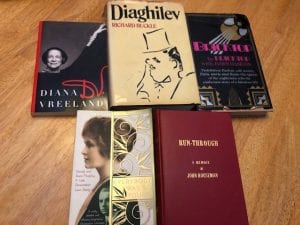
Everybody Was So Young: Gerald and Sara Murphy: A Lost Generation Love Story by Amanda Vaill
The creative couple who were friends with Picasso, Fitzgerald and Leger, Natalia Goncharova taught them to paint scenery for the Ballet Russes. They were at the center of a vibrant community of artists — Details here
Run-Through: A Memoir by John Houseman
Vivid memories of 1930s-‘40s theatre and performance and work with the WPA Theatre Project, Orson Welles and the Mercury Theatre, Gertrude Stein’s 4 Saints in 3 Acts and so much more. If you think you know him from TV, you don’t – Houseman was part of it all and is a master storyteller — Details here
D.V. by Diana Vreeland
An exuberant memoir of exuberant living and fashion as art, with Diaghilev, Cole Porter, Josephine Baker and more — Details here
Bricktop by Bricktop with James Haskins
The iconic African American singer Cole Porter wrote “Miss Otis Regrets” for shares her Paris cafe life — Details here
Diaghilev by Richard Buckle
An essential biography of the creative force behind the Ballet Russes —Details here


